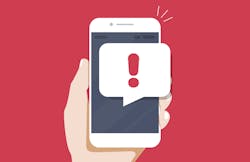Utilizing Internal Notifications in Parts Departments
As a fixed operations director who oversees 17 dealerships, William Demaree demands efficiency. Without it, his workweeks would be endless, as he looked at reports documented by parts managers, or listened to concerns from his overall staff of 70.
That helps explain why Demaree—the group director of fixed operations with Tom Wood Management—has become such a fan of his facilities’ digital customer retention suite, which integrates with departments’ DMS. Put simply, the technology allows his parts department employees to communicate quickly with dealership co-workers like technicians, mainly in an effort to deliver parts swiftly.
“It’s data driven,” Demaree says of the retention suite system by AutoPoint. “So, every statement that’s made [within the system] is time-stamped with who made it. Now it’s all documented—it’s really a timeline that cannot be erased.”
An overall goal of Demaree’s 17 parts departments is to continuously increase the hours of productivity in their shops. So, he says, the quicker they they can get parts to technicians, the more efficient—and profitable—they’re likely to be. And that’s why having a method for workers to quickly communicate within a dealership is imperative for parts departments.
The digital customer retention suite has served Demaree and company well; after beginning use of the AutoPoint system four years ago, his parts departments’ average “response time” for delivering parts to technicians has dropped from nearly 20 minutes down to 3 minutes.
Demaree, who has three decades in the auto industry under his belt, explains how a parts department can best go about adapting and utilizing a digital customer retention system.
Re-examine Procedures.
These days, there are multiple ways parts department employees can be notified when a job is quoted. Aside from digital retention systems like Demaree uses, texting and instant messaging remain popular at dealerships. Since there are always ways to get more efficient, he feels parts managers should always consider implementing innovative ways of in-house communication.
And, once dealership leaders have settled on a communication strategy, Demaree feels department managers should revisit their processes, pondering ways in which more efficient communication might impact workflow.
“Come up with your way that the [new communication method] will increase production and get your turn time lower,” Demaree says. “Start tracking the response time. Set a goal and start driving that number down. … Really start dialing in on the performance of employees—if something broke in that process, you can pretty easily go back and make a determination that somebody didn’t follow procedure, and tell who that someone is.”
In Demaree’s parts departments, the process for using their digital customer retention suite essentially works like this:
- Within the AutoPoint system, if a technician wants to communicate with the parts department, they click a flag within the system and leave notes.
- Soon, that flag pops up on a large monitor within the parts department—both visually and audibly—signifying that something requires a parts staffer’s attention.
- A parts counter employee soon responds to that flag, typically fulfilling a parts order, often with the assistance of a parts runner.
- Once the order is delivered to the technician, they note within the AutoPoint system that they received it.
Be Open Minded.
When adopting a new piece of communication technology it’s important that shop leaders are receptive to it. Otherwise, in Demaree’s experience, it’s tough to master the technology quickly.
“Just be open minded and own [the fact that] we’re going to use this system,” he says of communication systems like AutoPoint. “Parts guys typically like it. Because, if a store is brave enough to close the counter and not allow technicians in there, [it eliminates] a big distraction; you don’t have technicians hanging out in the parts department just jaw-jacking about how the day went. So, all of a sudden the counter’s empty, and it gives you a chance to grab the ticket and fulfil the order without being interrupted.”
Demaree has also found that, by taking advantage of vendor-provided training, dealerships can typically get employees to embrace new forms of in-house communication fairly quickly.
Above all else, Demaree has one tried and true method for getting his workforce to embrace and master new technology:
“Everybody uses it, or nobody uses it,” he says. “It can’t be something where just most people are using it. It has to be all-in or nothing. And then, once they get used to it, they [typically] won’t go back.”

